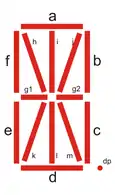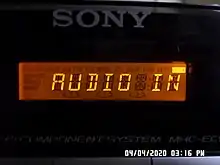Fourteen-segment display
A fourteen-segment display (FSD) (sometimes referred to as a starburst display or Union Jack display[1][2]) is a type of display based on 14 segments that can be turned on or off to produce letters and numerals. It is an expansion of the more common seven-segment display, having an additional four diagonal and two vertical segments with the middle horizontal segment broken in half. A seven-segment display suffices for numerals and certain letters, but unambiguously rendering the ISO basic Latin alphabet requires more detail.[3] A slight variation is the sixteen-segment display which allows additional legibility in displaying letters or other symbols.

A decimal point or comma may be present as an additional segment, or pair of segments; the comma (used for triple-digit groupings or as a decimal separator in many regions) is commonly formed by combining the decimal point with a closely 'attached' leftwards-descending arc-shaped segment.
Electronic alphanumeric displays may use LEDs, LCDs, or vacuum fluorescent display devices. The LED variant is typically manufactured in single or dual character packages, allowing the system designer to choose the number of characters suiting the application.
Often a character generator is used to translate 7-bit ASCII character codes to the 14 bits that indicate which of the 14 segments to turn on or off.[4]
Character Encoding

By lighting different elements, character can be displayed. We can represent each element with a bit, and by changing those we can display any character on it.
In 14-segment display, there is also an optional 15th segment which is a decimal point (denoted as "DP") which is mostly used to display floating point numbers.
Decimal
| Digit | 0 | 1 | 2 | 3 | 4 | 5 | 6 | 7 | 8 | 9 |
|---|---|---|---|---|---|---|---|---|---|---|
| Hex Code | 0xC3F | 0x406 | 0xDB | 0x8F | 0xE6 | 0xED | 0xFD | 0x1401 | 0xFF | 0xE7 |
Latin Alphabet

14-segment display is mostly used to display text because of 14 elements which allow all Latin alphabets to be displayed both in upper case and lower case (with few exceptions like "s").
| Alphabet | A | B | C | D | E | F | G | H | I | J | K | L | M | N |
|---|---|---|---|---|---|---|---|---|---|---|---|---|---|---|
| Hex code | 0xF7 | 0x128F | 0x39 | 0x120F | 0xF9 | 0xF1 | 0xBD | 0xF6 | 0x1209 | 0x1E | 0x2470 | 0x38 | 0x536 | 0x2136 |
| Alphabet | O | P | Q | R | S | T | U | V | W | X | Y | Z |
|---|---|---|---|---|---|---|---|---|---|---|---|---|
| Hex code | 0x3F | 0xF3 | 0x203F | 0x20F3 | 0x18D | 0x1201 | 0x3E | 0xC30 | 0x2836 | 0x2D00 | 0x1500 | 0xC09 |
Applications

Multiple-segment display devices use fewer elements than a full dot-matrix display, and may produce a better character appearance where the segments are shaped appropriately. This can reduce the number of driver components and power consumption.
Fourteen-segment gas-plasma displays were used in pinball machines from 1986 through 1991 with an additional comma and period part making for a total of 16 segments.
Fourteen and sixteen-segment displays were used to produce alphanumeric characters on calculators and other embedded systems. Applications today include displays fitted to telephone Caller ID units, gymnasium equipment, VCRs, car stereos, microwave ovens, slot machines, and DVD players.
Such displays were very common on pinball machines for displaying the score and other information, before the widespread use of dot-matrix display panels.
Incandescent lamp
Multiple segment alphanumeric displays are nearly as old as the use of electricity. A 1908 textbook [5] describes an alphanumeric display system using incandescent lamps and a mechanical switching arrangement. Each of 21 lamps was connected to a switch operated by a set of slotted bars, installed in a rotating drum. This commutator assembly could be arranged so that as the drum was rotated, different sets of switches were closed and different letters and figures could be displayed. The scheme would have been used for "talking" signs to spell out messages, but a complete set of commutator switches, drums and lamps would have been required for each letter of a message, making the resulting sign quite expensive.
Cold-cathode neon
A few different versions of the fourteen segment display exist as cold-cathode neon lamps. For example, one type made by Burroughs Corporation was called "Panaplex". Instead of using a filament as the incandescent versions do, these use a cathode charged to a 180 V potential which causes the electrified segment to glow a bright orange color.[6] They operated similarly to Nixie tubes but instead of the full-formed numeric shapes, used segments to make up numerals and letters.[7]
Examples
 A four character 14-segment display. Note unbroken top and bottom segments in comparison with a sixteen-segment display.
A four character 14-segment display. Note unbroken top and bottom segments in comparison with a sixteen-segment display. LCD fourteen-segment display as used on Hewlett-Packard's HP-41 range of programmable engineering calculators from the late 1970s.
LCD fourteen-segment display as used on Hewlett-Packard's HP-41 range of programmable engineering calculators from the late 1970s. 14 segment LCD as used on the Hewlett-Packard HP3478A Multimeter.
14 segment LCD as used on the Hewlett-Packard HP3478A Multimeter. LCD fourteen-segment characters on an after-market car stereo.
LCD fourteen-segment characters on an after-market car stereo. An inverted, backlit fourteen-segment LCD display used in a Sony MHC-EC55 Mini Hi-Fi Component System.
An inverted, backlit fourteen-segment LCD display used in a Sony MHC-EC55 Mini Hi-Fi Component System.
See also
References
- "AlphaNum G click with 14-segment LED display released". MikroElectronika Blog. MikroElektronika. Retrieved 11 March 2018.
- "EFM32 Series 0 LCD Driver Application Note" (PDF). Silicon Laboratories. p. 11. Retrieved 11 March 2018.
- Richard C. Dorf (ed.) The Electrical Engineering Handbook, CRC Press, Boca Raton, 1993, ISBN 0-8493-0185-8 page 1770
- Maxim Integrated. "Application Note 3211: Driving 14-Segment Displays". 2004.
- I. C. S. Reference Library Volume 4B, Scranton, International Textbook Company, 1908, no ISBN
- Burroughs b5791 Tube Data
- http://www.ineedcaffeine.com/content/the-burroughs-b7971/ Archived 2015-04-02 at the Wayback Machine Burroughs B7971 segmented display tube illustration, retrieved 2012 July 19
External links
![]() Media related to Fourteen segment displays at Wikimedia Commons
Media related to Fourteen segment displays at Wikimedia Commons
